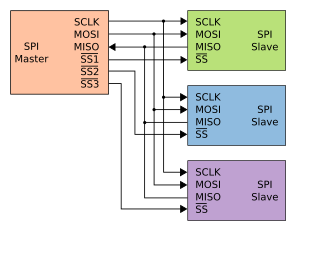
In computer architecture, a bus is a communication system that transfers data between components inside a computer, or between computers. This expression covers all related hardware components and software, including communication protocols.

A field-programmable gate array (FPGA) is an integrated circuit designed to be configured by a customer or a designer after manufacturing – hence the term "field-programmable". The FPGA configuration is generally specified using a hardware description language (HDL), similar to that used for an Application-Specific Integrated Circuit (ASIC). Circuit diagrams were previously used to specify the configuration, but this is increasingly rare due to the advent of electronic design automation tools.
HyperTransport (HT), formerly known as Lightning Data Transport (LDT), is a technology for interconnection of computer processors. It is a bidirectional serial/parallel high-bandwidth, low-latency point-to-point link that was introduced on April 2, 2001. The HyperTransport Consortium is in charge of promoting and developing HyperTransport technology.

A front-side bus (FSB) is a computer communication interface (bus) that was often used in Intel-chip-based computers during the 1990s and 2000s. The competing EV6 bus served the same function for AMD CPUs. Both typically carry data between the central processing unit (CPU) and a memory controller hub, known as the northbridge.

In a computer system, a chipset is a set of electronic components in an integrated circuit known as a "Data Flow Management System" that manages the data flow between the processor, memory and peripherals. It is usually found on the motherboard. Chipsets are usually designed to work with a specific family of microprocessors. Because it controls communications between the processor and external devices, the chipset plays a crucial role in determining system performance.
The Serial Peripheral Interface (SPI) is a synchronous serial communication interface specification used for short-distance communication, primarily in embedded systems. The interface was developed by Motorola in the mid-1980s and has become a de facto standard. Typical applications include Secure Digital cards and liquid crystal displays.
The MicroBlaze is a soft microprocessor core designed for Xilinx field-programmable gate arrays (FPGA). As a soft-core processor, MicroBlaze is implemented entirely in the general-purpose memory and logic fabric of Xilinx FPGAs.
The ARM Advanced Microcontroller Bus Architecture (AMBA) is an open-standard, on-chip interconnect specification for the connection and management of functional blocks in system-on-a-chip (SoC) designs. It facilitates development of multi-processor designs with large numbers of controllers and peripherals with a bus architecture. Since its inception, the scope of AMBA has, despite its name, gone far beyond microcontroller devices. Today, AMBA is widely used on a range of ASIC and SoC parts including applications processors used in modern portable mobile devices like smartphones. AMBA is a registered trademark of ARM Ltd.
In digital electronics three-state, tri-state, or 3-state logic allows an output port to assume a high impedance state, effectively removing the output from the circuit, in addition to the 0 and 1 logic levels.

The transistor count is the number of transistors on an integrated circuit (IC). Transistor count is the most common measure of IC complexity, although there are caveats. For instance, the majority of transistors are contained in the cache memories in modern microprocessors, which consist mostly of the same memory cell circuits replicated many times. The rate at which transistor counts have increased generally follows Moore's law, which observed that the transistor count doubles approximately every two years. As of 2017, the largest transistor count in a commercially available single-chip processor is 19.2 billion— AMD's Ryzen-based Epyc. In other types of ICs, such as field-programmable gate arrays (FPGAs), Xilinx's Everest/Versal has the largest transistor count, containing around 50 billion transistors.

Minimig is an open source re-implementation of an Amiga 500 using a field-programmable gate array (FPGA).
Intel Quartus Prime is programmable logic device design software produced by Intel; prior to Intel's acquisition of Altera the tool was called Altera Quartus II. Quartus Prime enables analysis and synthesis of HDL designs, which enables the developer to compile their designs, perform timing analysis, examine RTL diagrams, simulate a design's reaction to different stimuli, and configure the target device with the programmer. Quartus Prime includes an implementation of VHDL and Verilog for hardware description, visual editing of logic circuits, and vector waveform simulation.
Tarari is a company that spun out of Intel in 2002. It has created a range of re-programmable silicon based on Xilinx Virtex-4 FPGA and ASICs that offload and accelerate really complex algorithms such as XML Parsing, scanning for Computer viruses, email spam and intruders in Intrusion-prevention systems and Unified threat management appliances. As well as inspecting content its Content Processors can also transform content and they are used for XML transformation XSLT, compression, encryption as well as HD Video encoding for WMV and VC-1 formats.

Chip select (CS) or slave select (SS) is the name of a control line in digital electronics used to select one of integrated circuits out of several connected to the same computer bus, usually utilizing the three-state logic.
LatticeMico32 is a 32-bit microprocessor soft core from Lattice Semiconductor optimized for field-programmable gate arrays (FPGAs). It uses a Harvard architecture, which means the instruction and data buses are separate. Bus arbitration logic can be used to combine the two buses, if desired.
CoreConnect is a microprocessor bus-architecture from IBM for system-on-a-chip (SoC) designs. It was designed to ease the integration and reuse of processor, system, and peripheral cores within standard and custom SoC designs. As a standard SoC design point, it serves as the foundation of IBM or non-IBM devices. Elements of this architecture include the processor local bus (PLB), the on-chip peripheral bus (OPB), a bus bridge, and a device control register (DCR) bus. High-performance peripherals connect to the high-bandwidth, low-latency PLB. Slower peripheral cores connect to the OPB, which reduces traffic on the PLB. CoreConnect has bridging capabilities to the competing AMBA bus architecture, allowing reuse of existing SoC-components.

Xilinx ISE is a software tool produced by Xilinx for synthesis and analysis of HDL designs, enabling the developer to synthesize ("compile") their designs, perform timing analysis, examine RTL diagrams, simulate a design's reaction to different stimuli, and configure the target device with the programmer.
Virtex is the flagship family of FPGA products developed by Xilinx. Other current product lines include Kintex (mid-range) and Artix (low-cost), each including configurations and models optimized for different applications. In addition, Xilinx offers the Spartan low-cost series, which continues to be updated and is nearing production utilizing the same underlying architecture and process node as the larger 7-series devices.

Vivado Design Suite is a software suite produced by Xilinx for synthesis and analysis of HDL designs, superseding Xilinx ISE with additional features for system on a chip development and high-level synthesis. Vivado represents a ground-up rewrite and re-thinking of the entire design flow, and has been described by reviewers as "well conceived, tightly integrated, blazing fast, scalable, maintainable, and intuitive".










